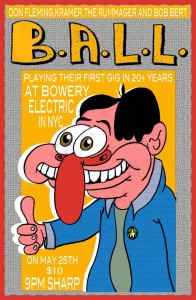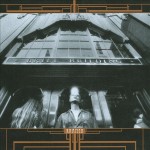 Venue: Bowery Electric (NY) May 25, 2013
Venue: Bowery Electric (NY) May 25, 2013
Date: May 25, 2013
Concert review and photo by John Pietaro
Gloomy skies and chilly rain moved in on this late-May evening, and the East Village was covered by that certain grayness it was once known for. If you squinted just enough, you could almost avoid the bistros and hipster joints that now line the Bowery in place of the dive-bars, restaurant supply houses and dusty bodegas that once were. Remember when there was an artful edginess to this town, downtown? While most of the creative community has been priced out of the chromium rentals that have sprung up everywhere that cool resides, thankfully there are still pockets of inspiration hidden between the Bowery Mission and the million-dollar views. Just a block north of where CBGB once stood, post-Punk NYC commanded the stage: B.A.L.L. reunited for the first time in 25 years. And at the crossroads of Bowery and Joey Ramone Place, no less.
The Bowery Electric contains a bit of the feel of CBs, and its basement haunt – where the live music plays – resounds with crackly amplifiers and stinging cymbals. The dungeon-like exposed brick may be missing the old LES graffiti, but as the black leather-and-jeans crowd in this tight room grew in anticipation of the music, it brought you back. The members of  B.A.L.L. had been there then – in that amazing time and place when the rebel yell of punk rock romanced the liberation of free jazz and downtown contemporary composition. Its off-spring included no wave and a wide pastiche of alternative experimental sounds. Kramer, B.A.L.L.’s bassist and a patron saint of this radical emulsion had studied with improvisational music guru Karl Berger and listened intently to the catalog of ESP Disk in his youth. By the late 70s and early 80s he was recording and touring with the likes of Daevid Allen’s NY Gong, the Chadbournes (with Eugene Chadbourne, John Zorn, and David Licht), Shockabilly and the Fugs; by ’85 he was a member of the Butthole Surfers. B.A.L.L. came along shortly thereafter, as well as Bongwater (with Ann Magnuson) and collaborations with GG Allin, Jad Fair and others. Kramer would, over the next few years, bring his NoiseNewYork studio to the forefront of this musical mélange of the cerebral and the rude and his record label Shimmy-Disc would stand as quite legendary. These days, Kramer’s homebase is Florida where he runs his Second-Shimmy label, which has released works by Zorn and others as well as Kramer’s latest take on deconstructed pop, The Brill Building. He also mixes and masters the albums of many other artists including, I need to state as a disclaimer, the debut disc of this writer’s band The Red Microphone, The Red Microphone Speaks! (2013).
B.A.L.L. had been there then – in that amazing time and place when the rebel yell of punk rock romanced the liberation of free jazz and downtown contemporary composition. Its off-spring included no wave and a wide pastiche of alternative experimental sounds. Kramer, B.A.L.L.’s bassist and a patron saint of this radical emulsion had studied with improvisational music guru Karl Berger and listened intently to the catalog of ESP Disk in his youth. By the late 70s and early 80s he was recording and touring with the likes of Daevid Allen’s NY Gong, the Chadbournes (with Eugene Chadbourne, John Zorn, and David Licht), Shockabilly and the Fugs; by ’85 he was a member of the Butthole Surfers. B.A.L.L. came along shortly thereafter, as well as Bongwater (with Ann Magnuson) and collaborations with GG Allin, Jad Fair and others. Kramer would, over the next few years, bring his NoiseNewYork studio to the forefront of this musical mélange of the cerebral and the rude and his record label Shimmy-Disc would stand as quite legendary. These days, Kramer’s homebase is Florida where he runs his Second-Shimmy label, which has released works by Zorn and others as well as Kramer’s latest take on deconstructed pop, The Brill Building. He also mixes and masters the albums of many other artists including, I need to state as a disclaimer, the debut disc of this writer’s band The Red Microphone, The Red Microphone Speaks! (2013).
B.A.L.L.’s front man, vocalist and guitarist Don Fleming also carries with him a certain pedigree. After working for years in regional new wave bands, he first came to cult prominence as the voice of the Velvet Monkeys and then joined Half-Japanese with Jad Fair. Fleming was inspired by the work of Lou Reed and the origin of the Velvet Monkeys name is found in a combination of both the Velvet Underground and, yes, the Monkees. You can hear the Reed inspiration still back there in his searing guitar work that is just as driven by bluesy R&B runs. However, for the past dozen years he has worked at the Alan Lomax Archives, these days serving as its Executive Director.
The band has had two drummers from the start as Kramer wanted to capture the feel of double drummers that he heard at George Harrison’s ‘Concert for Bangladesh’ (there it was Ringo and the brilliant Jim Keltner). Jay Spiegel was a member of the Velvet Monkeys and Half-Japanese before joining this band, and then after the initial break-up, he left with Fleming to form the alternative rock band Gumball and also played briefly with Dinosaur Jr and did some work with Thurston Moore as well.
Drummer/percussionist David Licht, another veteran of the downtown experience, served as the “other” through most of the original B.A.L.L. years. A founding member of the Klezmatics, Licht was also the pulse of Shockabilly and then Bongwater, but he is also noted for work with Ned Rothenberg, John Zorn and Tom Cora. Licht had worked very closely with Kramer on numerous projects so when B.A.L.L. came to be it was natural that he would be immediately engaged for it; he left the band in ’88 as things began to fall apart. It was disappointing that for this reunion show, Licht was not present. However Bob Bert of Sonic Youth and Pussy Galore fame was a fitting substitute and walloped the old numbers into a throbbing heartbeat along with Spiegel.
B.A.L.L. has always been known for its sense of parody and wicked humor. None of the old theatrical antics were present at the Bowery Electric but the musical sneer was unmistakable. The ensemble took to the stage and launched off into this material (which, as rumor has it, they’d only prepared for the night before), with a glint in the eye. The audience erupted and those down front pounded the stage. The band laughed and shouted over the rumble of double drumming and snaking guitar and bass lines. Fleming’s voice bellowed warmly whenever Kramer’s bass met his range and then improvised new counter-points. In the lives of band mates on the road, anything is possible and the hardships of the business have withered away many a union. But there was no indication of old animosity as Fleming came to the lip of the stage, in reach of the mixed-age group dressed in Bowery black. Kramer popped up and down on as the musical heights rang through the club, pointing the neck of his vintage Hofner violin bass to the hot lights and disco ball hovering just above. Strapless, as always, he seems to at once embrace his instrument and dance around it.
 A welcome sound was B.A.L.L.’s signature guitar and bass duo leads; during points when the rhythm would break and Fleming would embark on a swirling buzzsaw guitar solo, he was joined seconds into it by fluid bass improv raked over distortion. Here’s where the band differs from most others of their generation, of any generation. The ingredients of postmodernism will simply not go away and seemed to thrive on the feedback, primal screams and garage rock façade. Think back to Television and then to Richard Hell’s Voidoids and then to the work of its thrilling, inventive guitarist Robert Quine as he became part of the experimental tapestry beyond. At their best B.A.L.L. seemed to encapsulate all of this at once. At this reunion show there were few points of free play and I must admit I longed for more. As the tension would build in the music, the piece would come to its conclusion, even when there surely was room to take it further out. But no complaints here as the band was living in the moment and offered up “single” versions which filled the house and loomed over the shouting, waving audience like a sparkling storm cloud. There were no dull moments and from my spot on the stairwell that led into the main crowd area, the air was electric.
A welcome sound was B.A.L.L.’s signature guitar and bass duo leads; during points when the rhythm would break and Fleming would embark on a swirling buzzsaw guitar solo, he was joined seconds into it by fluid bass improv raked over distortion. Here’s where the band differs from most others of their generation, of any generation. The ingredients of postmodernism will simply not go away and seemed to thrive on the feedback, primal screams and garage rock façade. Think back to Television and then to Richard Hell’s Voidoids and then to the work of its thrilling, inventive guitarist Robert Quine as he became part of the experimental tapestry beyond. At their best B.A.L.L. seemed to encapsulate all of this at once. At this reunion show there were few points of free play and I must admit I longed for more. As the tension would build in the music, the piece would come to its conclusion, even when there surely was room to take it further out. But no complaints here as the band was living in the moment and offered up “single” versions which filled the house and loomed over the shouting, waving audience like a sparkling storm cloud. There were no dull moments and from my spot on the stairwell that led into the main crowd area, the air was electric.
Some of the old material heard included their cover of Ringo Starr’s “It Don’t Come Easy”, sang by Spiegel, but as always, the B.A.L.L. version was world’s away. The lyric, there in the dark of a damp Bowery night spot in 2013 seemed to speak of the band’s journey and with it, all of us who remember the time and place. They shouted through “The Ballad of Little Richard”, with all of its jagged rhythmic obstacles carefully navigated. And then when they would lean on a groove and the bass line would tease the audience with a discofied throb, the house rocked on as if listening to a hit blaring out of the latest MP3 collection, arms flowing overhead, butts swaying, bottles of Bud aloft.
The stage lights appeared to grow hot as Fleming left a guitar solo midstream and placed his ax down at the foot of an amplifier, He snuck away as his instrument emitted a whirling feedback, growing progressively louder. The two drummers exploded into a dual (perhaps duel) solo statement, with tom-tom accents, cymbal bursts, rim-shots and ratamacues shooting back and forth and back again. Kramer’s fuzz bass moaned over them and then was placed on the stage with the grinding feedback moaning and growling underneath, now matching and embellishing Fleming’s guitar wail, and he too ran into the “wings”. The drummers pounded on, evoking a kind of savage ‘(Buddy) Rich vs (Max) Roach’ vision as crash cymbals waved violently and threw the spotlights’ glare around the hall. Culminating in a series of angry sixteenth notes racing faster and faster and then a final accented boom and they too were off. The air thickened with the fading sounds of audio noise and ear drum ringing as the music claimed the night.
And the street.

